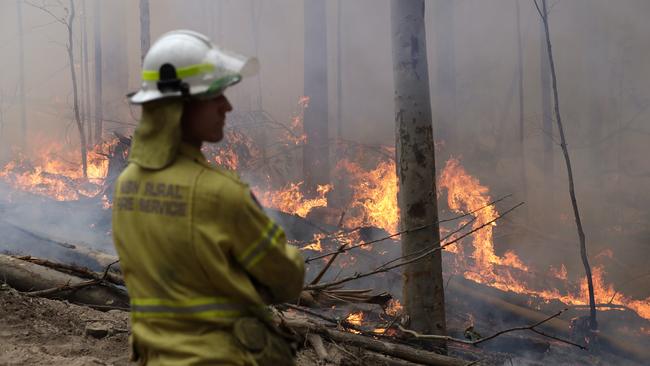
The explosion of the Soviet nuclear reactor was “a crisis of legitimacy from which the regime did not recover”, Greenpeace Australia boss David Ritter reminded supporters last week, with typical understatement.
After a summer of firestorms, “we have travelled through time and space and woken up in another country”, he continued.
The taboo around talking about climate change during a crisis has been smashed. Greenpeace wants to seize the moment and “ensure the bushfire crisis continues to be framed as a symptom of the climate emergency”. The single-cause obsession of the climate-explains-everything movement is a gift to bad governments. All manner of public policy and administrative failures can now be duckshoved to the weather gods.
The quiet Australians have already worked this out. On talkback radio (recommended by pharmacists as an antidote to Twitter), few if any callers have wanted to talk about climate policy in recent weeks.
Hazard reduction, rather than the reduction of emissions, was at the top of their list, backed by calls for stronger containment lines.
They are on solid empirical ground. The contribution of accumulated organic matter to fires was understood long before European settlement. Of the three factors that govern the intensity of fires — heat, oxygen and fuel — it is the only one that can be controlled easily by humans.
Every reputable authority on the subject, from the CSIRO to Forest Fire Management Victoria, agrees. “Fuel management reduces the spread and intensity of bushfires, which makes suppression more achievable and safer,” reads the FFM’s guide to managing bushfire risks.
We can only speculate why Victorian Premier Daniel Andrews played down the importance of fuel management in an extraordinary press conference last week, backed by Victorian Country Fire Authority chief officer Steve Warrington, who criticised the “hysteria” over backburning as “an emotional load of rubbish”.
Perhaps it is part of the “paradigm shift” declared by the boss of Greenpeace. Perhaps Andrews also wants to seize the moment and join the climate-explains-everything movement.
Or perhaps he is embarrassed by his government’s failure to implement recommendation 56 of the royal commission into Victoria’s 2009 Black Saturday bushfires: conduct prescribed burning across 5 per cent of public land.
By that measure, the Andrews government should have burnt about 400,000ha last financial year but, as Rachel Baxendale reported in The Australian last week, it managed to burn only 130,044 ha.
A premier who is really driven by evidence-based science, as Andrews claims to be, surely would be obliged to consider other variables before putting everything down to climate.
Our relationship with the bush, for example, has changed substantially in the past 50 years. Humans once tamed the wilderness. Today it tames us, restricting our ability not only to extract resources but also to resist its fury. National parks, as they were conceived at the end of the 19th century, were designed for both recreation and conservation. In areas of fire danger they were crisscrossed with fire trails.
With the arrival of Deep Green environmentalism in the 1970s, we chose a more overgrown path. The wilderness was declared pristine, visitors were made to feel unwelcome and conservation areas were sanctified as places untouched by the human stain.
The NSW Wilderness Act 1987, which was introduced by an earnest 40-something environment minister called Bob Carr, enshrined the romantic notions contaminating the debate. Wilderness was defined as territory “that has not been substantially modified by humans and their works or is capable of being restored to such a state”. Few if any places on earth could claim such status, particularly in Australia where the landscape, flora and fauna have been managed for 60,000 years, often through the application of fire.
By declaring new national parks, as Carr did later as premier, and letting nature take its course, the vegetation grew dense, weeds thrived and the fuel load mounted.
When fires break out, firefighters find the terrain almost impenetrable. There are no containment lines from which to take a stand. Fire becomes its own master.
Absorbing the lessons from this angry summer will require a paradigm shift, though not the one for which activists hanker. Fire and drought have fuelled growing sentiment that we are ill-prepared for long periods of heat and aridity.
In an era when, for better or worse, we look to the state to shoulder risk, state and federal governments must find better ways of providing water, protecting our agricultural sector from drought, managing bushfires and cleaning the environment.
This summer’s fires have already brought a significant change, unimagined by the drafters of the Constitution.
The inadequacies of state administrations and the goading by Morrison’s cultural opponents have forced the federal government into the frontline.
Bushfire management has joined energy, water, education and health in the portfolio of poisoned chalices that now requires the close attention of Canberra.
While constitutional conservatives fiddle nervously with their bow ties, there is at least an upside to this seemingly inevitable development. It will allow the federal government to seize the bushfire management agenda and to promote investment in bushfire mitigation measures as essential national infrastructure.
The cost of clearing adequate containment lines to protect human settlements from fires is comparable with the expense of roads, rail and airports.
The development is also likely to require the compulsory acquisition of property and changes to native vegetation legislation, not to mention the odd fight with misanthropic do-gooders. But, hey, if this is indeed an emergency, who could object to that?
The destruction of property and lives on the scale we are experiencing, not to mention the plight of wildlife, presents the opportunity to take the high ground on the security of containment lines, just as the Abbott government won the argument on the security of borders.
Nick Cater is executive director of the Menzies Research Centre.





The outlook is grim for Scott Morrison’s regime in the minds of his opponents. Having declared the bushfire season to be the Prime Minister’s “Chernobyl moment”, his Berlin Wall moment surely is not far away.